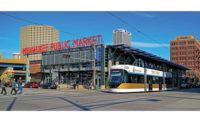All politics is local, or so the saying goes. The same could be said of the complex, potentially contentious nature of transportation construction, which may involve any number of unique, location-specific issues and interests. It is because of transportation's inherent intricacies that agencies in Texas and Louisiana are casting a wider net to develop viable alternatives for getting projects and programs up and running as efficiently as possible while also meeting the demands of a mobile marketplace.
The ability to meet those requirements is a key reason why many agencies have called on HNTB Corp., ENR Texas & Louisiana's Design Firm of the Year.
A number of key commissions over the past 12 months have solidified HNTB's standing as the region's top transportation-oriented designer. Last summer, for example, Texas Dept. of Transportation (TxDOT) selected HNTB to provide statewide engineering procurement services to develop and implement planned public-private partnership projects as well as for such delivery methods as concession and design-build.
Among them is the $818-million Dallas Horseshoe, a project to improve Interstates 30 and 35E and construct nine bridges over the Trinity River and Dallas Floodway. For the $4.7-billion, 25-mile U.S. 290 corridor rebuild in Houston, HNTB serves as TxDOT's program management consultant, assisting the agency in fast-tracking the project by 20 years.
In Louisiana, HNTB recently completed the Baton Rouge-New Orleans Intercity Rail Feasibility Study, commissioned by the Capital Region Planning Commission, the New Orleans Regional Planning Commission and the Baton Rouge Area Foundation. The study calls for an initial capital investment of $262 million, compared with a previous estimate of $448 million. The project, should it proceed, would help 1.4 million commuters.
HNTB also has been instrumental in helping manage Louisiana Dept. of Transportation and Development's (LaDOTD's) $90-million Paths to Progress Program (P2P), sustaining the momentum of the state's post-Katrina infrastructure recovery.
More than a half century of providing a variety of services in both states gives HNTB a vast amount of experience to leverage, says Tom O'Grady, president of the firm. However, the past goes only so far in tackling 21st-century transportation challenges.
"It comes down, as it always has, to understanding what's important to each agency," says O'Grady.
"In Texas, you have the advantage of strong funding sources and public recognition that transportation is a critical need," he explains. "The state is focused on accelerating projects through various review processes, using whatever the most appropriate delivery method is while still meeting their regulatory and financial stewardship responsibilities."
In Louisiana, however, project funding has proven more difficult to come by, making maintenance of existing infrastructure a primary focus, and one requiring creative solutions.











